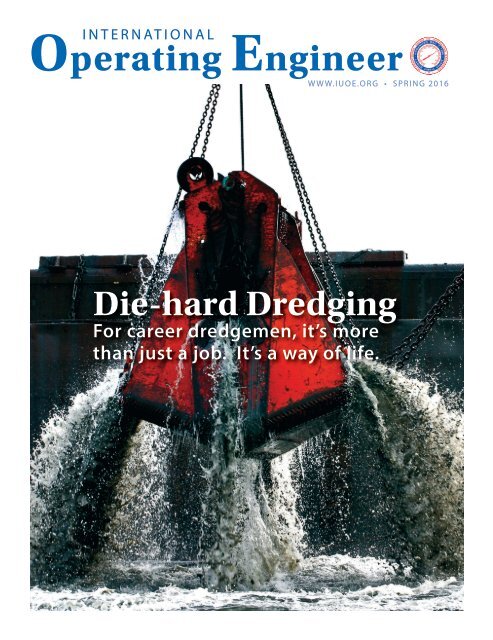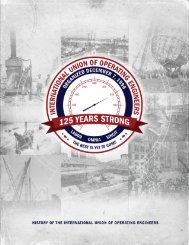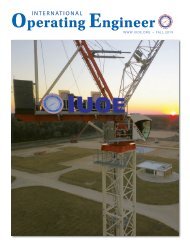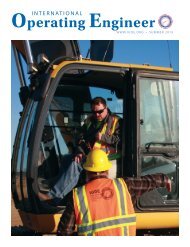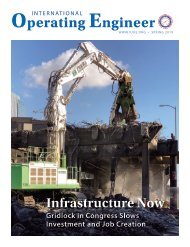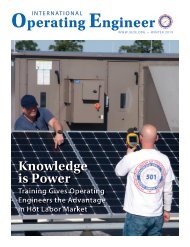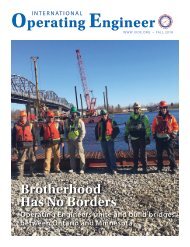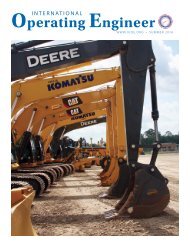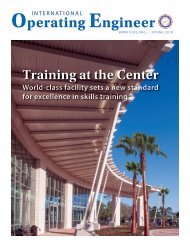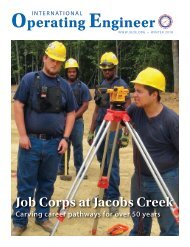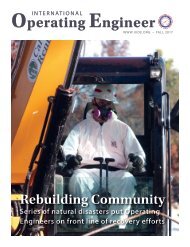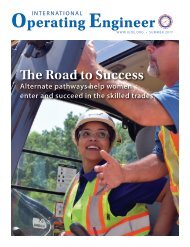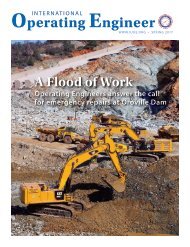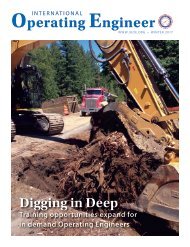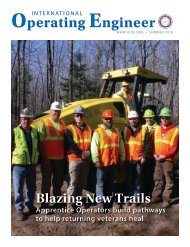International Operating Engineer - Spring 2016
The quarterly magazine of the International Union of Operating Engineers.
The quarterly magazine of the International Union of Operating Engineers.
Create successful ePaper yourself
Turn your PDF publications into a flip-book with our unique Google optimized e-Paper software.
i n t e r n at i o n a l<br />
<strong>Operating</strong> <strong>Engineer</strong><br />
WWW.IUOE.ORG • SPRING <strong>2016</strong><br />
Die-hard Dredging<br />
For career dredgemen, it’s more<br />
than just a job. It’s a way of life.
i n t e r n at i o n a l<br />
<strong>Operating</strong> <strong>Engineer</strong><br />
<strong>Spring</strong> <strong>2016</strong> • Volume 159, No. 2<br />
Brian E. Hickey, Editor<br />
Jay C. Lederer, Managing Editor<br />
16 SEATT Training Milestone<br />
Program graduates first class of operators<br />
08 Deadly Dust<br />
OSHA’s new silica rule will save lives<br />
12 Cover: Die-hard Dredging<br />
More than just a job, it’s a lifestyle<br />
16 Election <strong>2016</strong>: Special Series<br />
Republican nominee “loves” right-to-work laws<br />
Departments<br />
05 From the General President<br />
06 Education & Training<br />
08 HAZMAT<br />
10 Healthcare<br />
16 Politics & Legislation<br />
20 Canadian News<br />
24 GEB Minutes<br />
32 Union Death Benefit<br />
[cover] Buckets of sediment are dredged from shipping<br />
channels at the Port of Redwood City in California by<br />
members working for R. E. Stait.<br />
[photo] John O. Matos, IUOE Local 3<br />
2<br />
INTERNATIONAL OPERATING ENGINEER<br />
SPRING <strong>2016</strong> 3
<strong>International</strong> <strong>Operating</strong> <strong>Engineer</strong><br />
(ISSN 0020-8159) is published by the:<br />
<strong>International</strong> Union of<br />
<strong>Operating</strong> <strong>Engineer</strong>s, AFL-CIO<br />
1125 17 th Street, NW<br />
Washington, DC 20036<br />
Subscription Terms - $5 per year<br />
Change of Address - Requests must<br />
be submitted in writing to the IUOE<br />
Membership Department (address<br />
above). Include your new address,<br />
registration and local union number.<br />
POSTMASTERS – ATTENTION:<br />
Change of address on Form 3579<br />
should be sent to:<br />
<strong>International</strong> <strong>Operating</strong> <strong>Engineer</strong><br />
Mailing List Dept.<br />
1125 17th St., NW, 3rd Floor<br />
Washington, DC 20036<br />
Publications Mail Agreement No.<br />
40843045<br />
Canada Post:<br />
Return undeliverables to<br />
P.O. Box 2601, 6915 Dixie Rd,<br />
Mississauga, ON L4T 0A9<br />
Printed in the U.S.A.<br />
<strong>International</strong> Union of <strong>Operating</strong> <strong>Engineer</strong>s<br />
AFL-CIO<br />
general officers<br />
James T. Callahan, General President<br />
Brian E. Hickey, General Secretary-Treasurer<br />
Jerry Kalmar, First Vice President<br />
Russell E. Burns, Second Vice President<br />
James M. Sweeney, Third Vice President<br />
Robert T. Heenan, Fourth Vice President<br />
Daniel J. McGraw, Fifth Vice President<br />
Daren Konopaski, Sixth Vice President<br />
Michael Gallagher, Seventh Vice President<br />
Greg Lalevee, Eighth Vice President<br />
Terrance E. McGowan, Ninth Vice President<br />
Louis G. Rasetta, Tenth Vice President<br />
Mark Maierle, Eleventh Vice President<br />
Randy Griffin, Twelfth Vice President<br />
Douglas W. Stockwell, Thirteenth Vice President<br />
Ronald J. Sikorski, Fourteenth Vice President<br />
Got Big<br />
News<br />
?<br />
from Your<br />
Local<br />
We want to<br />
hear about it.<br />
trustees<br />
Kuba J. Brown, Chairman<br />
Bruce Moffatt, Trustee<br />
James T. Kunz, Jr., Trustee<br />
Joseph F. Shanahan, Trustee<br />
Edward J. Curly, Trustee<br />
<strong>International</strong> <strong>Operating</strong> <strong>Engineer</strong><br />
appreciates the stories and<br />
photos we receive from<br />
local affiliates throughout<br />
North America. Send us your<br />
submissions or ideas for stories<br />
you would like us to consider.<br />
Send your submissions, plus<br />
photos (digital images are<br />
preferred), to Jay Lederer<br />
at jlederer@iuoe.org, or mail<br />
1125 Seventeenth Street, N.W.,<br />
Washington, D.C., 20036<br />
From the General President<br />
Making the Most of Opportunity<br />
Meeting a challenge head-on is how we operate<br />
We have a big year ahead us. The<br />
construction season has begun, the<br />
economy is coming around, more<br />
money is being invested and more<br />
work hours for IUOE members as a<br />
result. We have a great opportunity to<br />
increase our market share and grow<br />
our ranks through organizing. And,<br />
there’s that small matter of electing a<br />
new President.<br />
Like any year, we will have<br />
opportunities and challenges.<br />
It has been a very challenging<br />
time politically, with attacks across<br />
the country by right-wing groups<br />
attempting to diminish our voice and<br />
roll back our basic legal protections.<br />
But it’s not all bad news; in fact we have<br />
had some solid victories along the way.<br />
The federal highway bill that passed<br />
at the very end of last year was a huge<br />
victory for <strong>Operating</strong> <strong>Engineer</strong>s.<br />
The bill – Fixing America’s Surface<br />
Transportation or FAST Act – is a fully<br />
funded, $305 billion dollar program<br />
over the next five years and the largest<br />
piece of job creating legislation coming<br />
out of the federal government.<br />
The legislation includes $70 billion<br />
dollars in new revenue for the Highway<br />
Trust Fund and in the first year both<br />
the Highway Program and the Transit<br />
Program have significant increases.<br />
The following four years grow at slower<br />
rates, but the program is on solid<br />
footing. All major funding provisions<br />
require the payment of Davis-Bacon<br />
prevailing wages to <strong>Operating</strong><br />
<strong>Engineer</strong>s.<br />
On healthcare, we won a two-year<br />
delay of the Affordable Care Act’s<br />
“Cadillac Tax” on high cost health<br />
insurance plans. The tax would have<br />
ensnared a number of IUOE plans and<br />
would grab more health and welfare<br />
plans over time. The postponement<br />
until 2020 now leaves the issue in the<br />
hands of the next administration and<br />
Hillary Clinton has said publicly and<br />
told us privately, that she favors a full<br />
repeal of the tax.<br />
But most of the action has been in<br />
state capitals and while we can claim<br />
credit in a number of states, these have<br />
been defensive victories. We fought off<br />
some of the worst attacks, but still had<br />
some setbacks.<br />
On Right-to-work, our locals in<br />
Missouri and New Mexico played key<br />
leadership roles in fighting off this<br />
extreme anti-union legislation. And in<br />
Kentucky, <strong>Operating</strong> <strong>Engineer</strong>s made<br />
sure that the state legislature held onto<br />
a pro-union majority, heading off antiworker<br />
bills there.<br />
In Michigan, <strong>Operating</strong> <strong>Engineer</strong>s<br />
led the building trades’ effort<br />
to challenge petition signatures<br />
circulated by the Associated Builders<br />
and Contractors to repeal the state<br />
prevailing wage law. They were able<br />
to disqualify tens of thousands of<br />
signatures and stop the effort.<br />
Unfortunately, we did experience<br />
a setback earlier this year in West<br />
Virginia as right-wing Republicans in<br />
that state reversed generations of prolabor<br />
solidarity by passing a Rightto-work<br />
law and repealing prevailing<br />
wage. However, we are already fighting<br />
back there.<br />
Angered by their legislators’<br />
retreat from labor-friendly positions,<br />
eight West Virginia IUOE members<br />
have declared their candidacies for<br />
legislative office. In addition, all<br />
legal avenues are being explored<br />
and lawsuits have been filed by labor<br />
groups to overturn Right-to-work.<br />
I can only touch on a few of the fights<br />
that IUOE locals have had to wage,<br />
expending valuable time and resources<br />
fighting back against the right-wing<br />
Republican agenda. The list is a lot<br />
longer and the attacks keep coming.<br />
What we can clearly see however, is<br />
[James T. Callahan]<br />
that political engagement at every level<br />
is a necessity if we are to maintain our<br />
collective bargaining rights, wages,<br />
benefits and pensions into the future.<br />
This year we have another big<br />
election to win. The race for President,<br />
and the policies the two candidates<br />
promote, will have a ripple effect on<br />
all the local, state and Congressional<br />
elections being contested in November.<br />
The presumed nominees, Hillary<br />
Clinton and Donald Trump, both claim<br />
to be on the side of working men and<br />
women.<br />
But only Clinton has a record of<br />
working with unions to create jobs.<br />
Trump has fought unions and denied<br />
workers a voice at the bargaining table.<br />
I urge everyone to look closely at their<br />
records and not just their rhetoric or<br />
showmanship. A great place to start is<br />
www.engineersaction.org<br />
Volunteering some time to work<br />
on local campaigns can make a real<br />
difference for your family and your<br />
fellow <strong>Operating</strong> <strong>Engineer</strong>s. Who<br />
knows? It might even be fun. I hope<br />
everyone will take some time to do so<br />
this year.<br />
As we go to press, we are closely<br />
watching the developments of a<br />
massive wildfire in and around Fort<br />
McMurray, Alberta. Many <strong>Operating</strong><br />
<strong>Engineer</strong>s living and working there<br />
have been affected. Please keep them<br />
in your thoughts and prayers. Work<br />
safe.<br />
4<br />
INTERNATIONAL OPERATING ENGINEER<br />
SPRING <strong>2016</strong> 5
Education & Training<br />
SEATT Training Program Graduates First Class<br />
Petro-chemical operators committed to advancing careers<br />
EARLY THIS YEAR, the Stationary<br />
<strong>Engineer</strong> Apprentice Training and<br />
Trust (SEATT) graduated its first class<br />
of operators at Western Refining in El<br />
Paso, Texas.<br />
During six weeks of intense training,<br />
the students were instructed in topics<br />
that all petro-chemical operators<br />
need to know to be safe, efficient, and<br />
productive.<br />
“It was challenging to get all the<br />
training completed in the time we<br />
were allowed. However, everyone was<br />
ready for the next step in their career,”<br />
explained Local 351 Trainer Jay Clark.<br />
The bedrock of the SEATT<br />
program are the program’s trainers.<br />
SEATT recruited highly skilled and<br />
experienced operators from the<br />
refinery to instruct the students. Local<br />
351 Union Chairman Lauren Titus was<br />
one of those talented instructors.<br />
Classes ranged from Basic Hand<br />
Tools to Valves, Boilers, Reactors,<br />
Distillation, Turbines, Compressors,<br />
Instrumentation, Furnaces, Cooling<br />
Towers, Heat Exchangers, Physics,<br />
Chemistry, Safe Work Permitting and<br />
Hot Work Permitting, as well as various<br />
other subjects.<br />
The NTF Blackboard program was<br />
used when the SEATT program was<br />
being designed. Blackboard’s ability<br />
to be tailored to unique equipment,<br />
and units, in the refinery industry has<br />
proven to be a valuable asset.<br />
SEATT looks forward to continuing<br />
to work with participating employers<br />
in establishing a highly skilled pool of<br />
future petro-chemical operators.<br />
IMAGINE WHAT’S NEXT.<br />
Get the ultimate view of where construction is going.<br />
Go hands-on with the new technologies spread out over 2,400,000<br />
square feet of exhibition space. Learn next-gen techniques, tools<br />
and ideas from over 100 education sessions. From earthshaking<br />
big iron to groundbreaking innovations, CONEXPO-CON/AGG 2017<br />
is where over 130,000 construction industry professionals from<br />
around the world go to stay ahead of their competition.<br />
To see who’s included in our 2,400+ exhibitors,<br />
visit conexpoconagg.com<br />
IF IT’S NEW,<br />
IT’S HERE.<br />
6<br />
INTERNATIONAL OPERATING ENGINEER<br />
March 7-11, 2017 | Las Vegas Convention Center | Las Vegas, USA<br />
Co-located<br />
with<br />
®<br />
SPRING <strong>2016</strong> 7
HAZMAT<br />
Deadly Dust: OSHA’s New Silica Rule Will Save Lives<br />
Confined Spaces 101 Mobile App Now Available<br />
THE OCCUPATIONAL SAFETY<br />
AND HEALTH ADMINISTRATION<br />
(OSHA) announced its final rule<br />
in March to improve protection for<br />
workers exposed to respirable silica<br />
dust. The final rule is effective June 23,<br />
<strong>2016</strong>. The rule is written as two different<br />
standards: one for construction 29<br />
CFR 1926.1153 Respirable Crystalline<br />
Silica, and one for general industry<br />
and maritime 1910.1053 Respirable<br />
Crystalline Silica.<br />
Employers covered by the<br />
construction standard have until<br />
Jun 23, 2017 to comply with most<br />
requirements. Employers covered by<br />
the general industry and maritime<br />
standard have until June 23, 2018<br />
to comply with most requirements.<br />
There is additional time to offer<br />
medical exams to some workers and<br />
for hydraulic fracturing employers to<br />
install dust controls to meet the new<br />
exposure limit.<br />
Crystalline silica is a common<br />
mineral found in many naturally<br />
occurring materials like sand, concrete,<br />
stone and mortar. It is also used in<br />
many products like glass, pottery,<br />
ceramics, bricks, concrete and artificial<br />
stone.<br />
Inhaling very small (“respirable”)<br />
crystalline silica particles causes<br />
multiple diseases, including silicosis,<br />
an incurable lung disease that can lead<br />
to disability and death. Respirable<br />
crystalline silica also causes lung<br />
cancer, chronic obstructive pulmonary<br />
disease (COPD) and kidney disease.<br />
PICTURE THIS: You’re<br />
getting ready to tackle a<br />
job and you’re not sure if<br />
it’s a confined space. If it<br />
is, is it safe to enter? What<br />
do you do? The IUOE<br />
NTF National HAZMAT<br />
Program recently released<br />
a Confined Spaces 101 app<br />
that can help.<br />
Following OSHA’s<br />
guidelines and the Decision Flow<br />
Chart for the general industry found<br />
in OSHA regulation 29 CFR 1910.146,<br />
the app provides general guidance<br />
through questions and steps that need<br />
to be taken to help you decide whether<br />
the space is safe for entry or is a permitrequired<br />
confined space. Additional<br />
features include definitions, workers’<br />
notes, and additional<br />
references.<br />
Available for both<br />
Apple (iTunes) and<br />
Android (Google<br />
Play) devices, the<br />
app can be used<br />
without an Internet<br />
connection after it<br />
has been successfully<br />
downloaded. So if<br />
you’re at a remote jobsite, in a big city,<br />
or even at home, you will be able to use<br />
this app wherever and whenever you<br />
need it.<br />
Go to any search engine and type<br />
“Confined Spaces 101” and the logo<br />
above will appear.<br />
What does the silica Construction Standard require?<br />
About 2 million construction workers are exposed to respirable crystalline silica in over 600,000 workplaces.<br />
OSHA estimates that more than 840,000 of these workers are exposed to silica levels that exceed the new<br />
permissible exposure limit (PEL). The new PEL is 50 micrograms/cubic meter of air. The standard requires<br />
employers to limit worker exposures to respirable crystalline silica and to take other steps to protect workers.<br />
Employers can either use a control method laid out in Table 1 of the construction standard (see regulatory<br />
text and table 1 at www.osha.gov/silica/SilicaConstructionRegText.pdf), or they can measure workers’<br />
exposure to silica and independently decide which dust controls work best to limit exposures to the PEL in<br />
their workplaces.<br />
Regardless of which exposure control method is used, all construction employers covered by the standard<br />
are required to:<br />
• Establish and implement a written exposure control plan that identifies tasks that involve exposure<br />
and identifies methods used to protect workers. This includes procedures to restrict access to work<br />
areas where high exposure may occur.<br />
• Designate a competent person to implement the exposure control plan.<br />
• Restrict housekeeping practices that expose workers to silica where feasible alternatives are available.<br />
• Offer medical exams every 3 years for workers who are to wear a respirator for 30 or more days per<br />
year.<br />
• Train workers on work operations that result in silica exposure and ways to limit exposure.<br />
• Keep records of workers’ silica exposure and medical exams.<br />
What does the silica General Industry and Maritime standard require?<br />
About 295,000 workers are exposed to respirable crystalline silica in over 75,000 general industry and<br />
maritime workplaces. OSHA estimates that over 100,000 workers are exposed to silica levels that exceed the<br />
new PEL of 50 micrograms/cubic meter of air.<br />
The standard for general industry and maritime requires employers to:<br />
• Measure the amount of silica that workers are exposed to if it may be at or above the action level of<br />
25 micrograms/cubic meter of air averaged over an 8-hour day.<br />
• Protect workers from silica exposure above the PEL of 50 micrograms/cubic meter of air averaged<br />
over an 8-hour day.<br />
• Limit workers’ access to areas where they could be exposed above the PEL.<br />
• Provide respirators to workers when dust controls cannot limit exposures to the PEL.<br />
• Restrict housekeeping practices that expose workers to silica where feasible alternatives are available.<br />
• Establish and implement a written exposure control plan that identifies tasks that involve exposure<br />
and methods used to protect workers.<br />
• Offer medical exams every 3 years for workers exposed at or above the action level for 30 or more<br />
days per year.<br />
• Train workers on work operations that result in silica exposure and ways to limit exposure.<br />
• Keep records of workers’ silica exposure and medical exams.<br />
8<br />
INTERNATIONAL OPERATING ENGINEER<br />
SPRING <strong>2016</strong> 9
Healthcare<br />
IUOE Nurses Keep Up the Fight for Patient Rights<br />
and Worker Rights<br />
IN APRIL, more than 200 JNESO District Council 1<br />
health care workers gathered for their biennial convention<br />
in Atlantic City. Members attended seminars on emerging<br />
issues in health care, addressed union matters, and earned<br />
the continuing education units (CEUs) required to keep their<br />
licenses current.<br />
“Every other year, JNESO membership gathers for<br />
our Convention and it demonstrates the strength and<br />
unity of our organization,” said Elfrieda Johnson, Board<br />
President of JNESO District Council 1. “Our successes at the<br />
bargaining table and in the legislative arena are rooted in the<br />
participation and active engagement of our members, and I<br />
am thrilled with the record turnout at this year’s Convention.”<br />
Throughout the four day convention, members discussed<br />
various issues at length. Three priority areas that were<br />
addressed are often inter-related—the need to codify safe<br />
nurse-to-patient staffing ratios; addressing violence in<br />
the workplace; and supporting the expansion of collective<br />
bargaining rights for healthcare workers.<br />
Safe Nurse-to-Patient Staffing Ratios<br />
Representing more than 5,000 health care workers in New<br />
Jersey and Pennsylvania, JNESO has long advocated for safe<br />
nurse-to-patient staffing ratios in hospitals and ambulatory<br />
care centers throughout both states.<br />
In December 2015, nurses and patient advocates took a<br />
step toward legislative victory when safe staffing legislation<br />
was posted for a vote before the New Jersey Assembly Health<br />
Committee. After more than twenty years, this bill was finally<br />
voted upon by a legislative committee, and JNESO nurses<br />
were there to share their first-hand experiences and be a<br />
strong voice for safe nurse-to-patient staffing ratios.<br />
While this was indeed an historic step forward, the fight<br />
for full passage of safe staffing ratios in both state capitals<br />
continues.<br />
Violence in the Workplace<br />
The Occupational Safety and Health Administration<br />
(OSHA) reports that over 2 million American workers are<br />
victims of workplace violence each year. The health care<br />
industry leads all other sectors in the incidence of nonfatal<br />
workplace assaults; particularly in emergency departments<br />
[above] JNESO Board members are sworn in at<br />
convention. L to R: Board President, Elfrieda Johnson,<br />
Board members Valerie-Clary Muronda and Regina<br />
DiSalvio.<br />
and in psychiatric settings. Nurses serve on the frontlines<br />
of health care delivery, and are often the targets of violent<br />
encounters - both verbal and physical. Workplace violence<br />
continues to be a serious occupational risk that requires<br />
targeted responses from employers, law enforcement, the<br />
community, and state legislators.<br />
Collective Bargaining for Health Care Workers<br />
Patients and their families expect nurses and other health<br />
care workers to fight for them at the bedside, even when it<br />
conflicts with the profit motive of hospital administrators,<br />
insurance companies, and others in the health care industry<br />
who put the bottom line above patient interest and safety.<br />
When unionized nurses are fighting for their patients, the<br />
union is fighting for our nurses.<br />
Charles Wowkanech, president of the New Jersey State<br />
AFL-CIO, which represents one million working men and<br />
women and their families, addressed the convention. “Nurses<br />
advocating for patients and safety are doing so because they<br />
have protection from retaliation as unionized nurses. They<br />
are asking for standards on behalf of every patient in New<br />
Jersey, and every nurse and health care worker who cannot<br />
speak up. Their voices need to be heard!”<br />
10<br />
INTERNATIONAL OPERATING ENGINEER<br />
SPRING <strong>2016</strong> 11
Feature<br />
DECKHAND JAMES FAAS has many tattoos, but two of<br />
the most prominent ones are of a bucket dredge on his right<br />
hand and a cutter-head on his left. He’s worked on rigs using<br />
both during his 14-year career in dredging, as they are used<br />
to deepen shipping channels and remove underwater debris.<br />
However, the tattoos are more than just body art; they are<br />
an outward symbol of how working in this trade becomes so<br />
much a part of those who do it.<br />
“I can’t think of doing anything else,” said Leverman<br />
Steven Pryor. He’s been an <strong>Operating</strong> <strong>Engineer</strong> working on<br />
dredging rigs for 29 years. Growing up on the coast in Eureka,<br />
Calif., he was only eight years old when he decided he was<br />
going to work on the water. Today, he has no regrets in making<br />
that career choice.<br />
“I didn’t get a college degree, but I’ve had a great career<br />
that fed my family,” he said. His family includes “two-andthree-quarters<br />
grandkids” (one was still on the way at the<br />
time of this writing), and two sons, one of which, like Pryor,<br />
works on the water for Dutra.<br />
Not only do dredgemen travel and work long hours to<br />
support their families, but many work alongside family<br />
members. Even when there are no direct family connections,<br />
there is a distinct family feel on these rigs. Crewmembers<br />
often gather in the kitchen or around the grill to prepare<br />
lunch and jokingly argue about who’s been raiding the food<br />
in the pantry. They poke fun at each other the way siblings<br />
do, a sign of how comfortable they become on these floating<br />
jobsites.<br />
Being comfortable around your fellow crewmembers<br />
doesn’t just make going to work on a dredge easier; it’s vital<br />
to the safe functioning of the rig. The dangers of working<br />
on the water, such as climbing up wet steps and ladders,<br />
being around moving parts and equipment, stepping over<br />
gaps between rigs and boats or over lines and ropes, means<br />
crewmembers have to constantly be mindful of their own<br />
safety and that of their coworkers.<br />
For crews working in the yard, there are different dangers<br />
and challenges, including those that come with welding,<br />
working with electrical lines and having to fabricate parts in<br />
the shop for equipment built decades ago.<br />
[right] The crew aboard R. E. Stait’s DB Palomar includes, from left,<br />
Deckhand David Koue, Deck <strong>Engineer</strong> Fritz Fields, Deckhand Felix<br />
Castro, Leverman Bill Kombrink and Capt. Greg Center.<br />
[article & photos] by John O. Matos, IUOE Local 3<br />
Die-hard Dredging<br />
For career dredgemen, it’s more than<br />
just a job. It’s a way of life.<br />
12<br />
INTERNATIONAL OPERATING ENGINEER<br />
SPRING <strong>2016</strong> 13
Feature<br />
“Some of these rigs are World-War-<br />
II-era, built in the 1940s,” said Master<br />
Mechanic Greg Wright who works in<br />
the Manson Yard in Richmond, Calif.<br />
“You can’t just go out and buy the part;<br />
you have to make it yourself.”<br />
Yard crews consist of Heavy Duty<br />
Repairers (HDRs), but as Apprentice<br />
Remy Trifforiot pointed out, work on<br />
dredging rigs “is a totally different<br />
world” from what he learned working<br />
on loaders and dozers. That’s why HDR<br />
Fred Baca makes it a point to clarify<br />
that he is a Marine HDR.<br />
Though the work is often hard and<br />
dangerous and involves long weeks<br />
and long hours, it’s impossible to miss<br />
the die-hard enthusiasm members in<br />
this line of work have for their jobs.<br />
Part of that is because they understand<br />
the importance of what they do in the<br />
larger scheme of things.<br />
“What we do is important,” said<br />
Pryor, as he pointed to a large ship being<br />
unloaded in Stockton, Calif. “Look at<br />
that ship and consider all the jobs that<br />
one ship is tied to. If we weren’t here<br />
doing this, those ships couldn’t get in<br />
here and those jobs wouldn’t exist.”<br />
“Our work keeps the cost of shipping<br />
and the price of goods down,” added<br />
Deckhand Jason Shanahan. “What we<br />
do supports our whole economy.”<br />
It’s obvious that what dredgermen<br />
do creates close camaraderie and<br />
provides the satisfaction of skilled and<br />
challenging work, a sense of purpose<br />
and an understanding of the value<br />
of their job. It’s no wonder, then, that<br />
die-hard dredgers like Faas would be<br />
willing to wear their pride on their<br />
(tattooed) sleeves.<br />
Water Infrastructure Funding<br />
Awaits Action in Senate<br />
In March, the Senate Environment and Public Works Committee passed<br />
the Water Resources Development Act (WRDA) of <strong>2016</strong>. The $9.4 billion bill<br />
will support the nation’s ports, waterways and clean water infrastructure.<br />
The legislation will now go before the full Senate for a vote.<br />
This bill “prioritizes projects to improve ports and waterways for<br />
increased global competitive advantage and supports needed flood control<br />
projects that protect millions of people and billions of dollars’ worth of<br />
infrastructure,” said Senate Environment and Public Works Committee<br />
Chairman, Senator Jim Inhofe (R-OK).<br />
The legislation identifies $4.5 billion worth of water-related infrastructure<br />
projects and contains $220 million in direct emergency assistance for Flint,<br />
Michigan, and other communities where the drinking water supply is<br />
contaminated.<br />
In a letter to Senators, General President Callahan commented that,<br />
“the Water Resources Development Act will deliver immediate economic<br />
benefits to construction workers and the whole nation.” If the WRDA gets<br />
signed into law, it will create thousands of job opportunities for <strong>Operating</strong><br />
<strong>Engineer</strong>s.<br />
WRDA also authorizes $4.9 billion for drinking water and clean water<br />
infrastructure over five years. The bill would increase investments in the<br />
nation’s aging drinking water and wastewater infrastructure by modernizing<br />
State Revolving Loan Fund programs, reauthorizing funding to control<br />
sewer overflows and providing assistance to replace lead service lines.<br />
“Many Americans get their drinking water from crumbling pipes,” said<br />
Senator Barbara Boxer (D-CA), the committee’s ranking member. “This bill<br />
begins the much-needed work to ensure safe reliable drinking water.”<br />
In addition, the legislation would authorize 25 new Army Corps projects<br />
in 17 states, including projects to restore the Florida Everglades; revitalize<br />
the Los Angeles River; improve ports in Charleston, South Carolina; and<br />
provide flood and hurricane protection in Louisiana.<br />
The legislation includes full Davis-Bacon prevailing wage standards as<br />
it moved out of committee. An effort from right-wing Republican Senators<br />
to repeal the labor standard when it moves to the floor of the Senate is<br />
expected.<br />
[photos clockwise from top] Deckhand James Faas displays his tattoos; bucket of sediment dredged from the shipping channels at the Port<br />
of Redwood City; [L to R] Dutra Deckhand Jason Shanahan, Capt. Craig Haufler, Deckhand Albert Apodaca and Deckhand James Faas; Capt.<br />
Craig Hauffler andDeckhand Jason Shanahanwork at the Port of Stockton; the crew aboard Dutra’s DB 24 includes, from left, Site Safety and<br />
Health Officer Karen Maples, Deckhand Cody Mana, Deckhand Kenny Hasbrouck, Deck <strong>Engineer</strong> Mike Davis and Capt. John Boykin.<br />
14<br />
INTERNATIONAL OPERATING ENGINEER<br />
SPRING <strong>2016</strong> 15
Election <strong>2016</strong>: Special Series<br />
Republican Presidential Nominee “Loves”<br />
Right-to-Work Laws<br />
Donald Trump, the presumptive Republican presidential<br />
nominee, is in lockstep with the right-wing of his party<br />
on labor law. Adopted by the delegates at the national<br />
convention in 2012, the Republican Party platform is clear.<br />
It states: “We support the right of States to enact Right-to-<br />
Work laws and encourage them to do so to promote greater<br />
economic liberty. Ultimately we support the enactment of<br />
a National Right-to-Work law to promote worker freedom<br />
and to promote economic liberty.” Donald Trump agrees.<br />
In a recent interview, Donald<br />
Trump says, “My position on Right-towork<br />
is 100 percent. I love the Rightto-work.<br />
I like it better because it is<br />
lower. You are not paying the big fees<br />
to the unions…It gives great flexibility<br />
to the companies.” (You can listen to<br />
the Trump’s radio interview at www.<br />
engineersaction.org.)<br />
Right-to-work laws force union<br />
members to pay for services delivered<br />
to “free riders” – individuals who<br />
think it is ok to work under a collective<br />
bargaining agreement and let everyone<br />
else pay for maintaining and enforcing<br />
its provisions, even grievances.<br />
Trump is right. Right-to-work is<br />
lower. States with Right-to-work laws<br />
have lower wages, lower pensions, and<br />
less safe workplaces.<br />
Elected Republican Party leaders<br />
in Congress and State Capitols across<br />
the country have doggedly pursued the<br />
Right-to-work “plank” in the party’s<br />
platform. Four states have gone Rightto-work<br />
in just the last five years. Earlier<br />
this year, a Republican-controlled<br />
legislature in West Virginia, a state<br />
with a proud union tradition and some<br />
of the highest levels of public support<br />
for unions anywhere in the country,<br />
steamrolled public opinion and the<br />
Governor’s veto to enact Right-to-work<br />
laws. And it does not stop there. The<br />
Legislature also repealed the state’s<br />
prevailing wage law.<br />
Right-wing, anti-union forces are<br />
also mobilizing nationally. Failed<br />
Republican Presidential candidate<br />
and Kentucky Senator Rand Paul<br />
introduced Senate Bill 391, the National<br />
Right-to-Work Act. Twenty-seven other<br />
senators joined him as sponsors of<br />
the bill, including the Senate Majority<br />
Leader Mitch McConnell and former<br />
Republican presidential candidates<br />
in the Senate – Ted Cruz, Lindsey<br />
Graham and Marco Rubio. National<br />
Right-to-Work legislation, H.R. 612,<br />
was also introduced in the House<br />
of Representatives. Right-to-work<br />
will be one of the top issues on the<br />
congressional agenda if Donald Trump<br />
occupies the White House next year.<br />
TRUMP FIGHTS UNIONS; UNDERMINES<br />
LOCAL WAGE STANDARDS<br />
Donald Trump has pursued a race<br />
to the bottom in Right-to-work states.<br />
The Las Vegas Strip is 98% unionized<br />
for hospitality workers, members of<br />
UNITE-HERE. Stationary <strong>Engineer</strong>s<br />
– members of Local 501 – maintain<br />
a strong and growing presence in<br />
Southern Nevada, where they work<br />
closely with UNITE-HERE members<br />
to raise the standards for all workers<br />
in the industry. Members of Local 501<br />
have dramatically increased their size<br />
and strength in the city over the last<br />
few years, winning major organizing<br />
drives and achieving strong wage gains<br />
in their first contracts. Donald Trump<br />
seeks to undermine those standards.<br />
Despite its high levels of<br />
unionization, Nevada is a Right-towork<br />
state. It has high wage standards<br />
because of the strength of union<br />
members, but Donald Trump seeks to<br />
erode those standards. That should not<br />
be a surprise. Trump believes that the<br />
federal minimum wage of $7.25 – a rate<br />
that has not changed for seven years –<br />
should not be raised.<br />
Trump has said, “…wages are too<br />
high. We’re not going to be able to<br />
compete against the world.” In a<br />
different interview, Trump stated that,<br />
“Having a low minimum wage is not<br />
a bad thing for this country. We can’t<br />
have a situation where our labor is<br />
so much more expensive than other<br />
countries’ that we can no longer win.”<br />
In Las Vegas, Trump teamed up with<br />
billionaire casino tycoon Phil Ruffin to<br />
develop the Trump <strong>International</strong> Hotel,<br />
where they have aggressively fought a<br />
multi-year effort by 500 hotel workers<br />
to organize a union. According to the<br />
workers, they have been subjected to<br />
surveillance, intimidation, and even<br />
fired for supporting the union.<br />
Trump Ruffin Commercial LLC has<br />
pursued a classic anti-union campaign,<br />
hiring a union-busting consultant, and<br />
employing strategies to deny workers<br />
their rights and lower the industry’s<br />
local standards.<br />
Workers at Trump <strong>International</strong><br />
Las Vegas earn $3 less an hour than<br />
union members that work identical<br />
jobs on the Strip. They don’t receive<br />
pensions and they have to pay for their<br />
own health care. Workers at Trump<br />
<strong>International</strong> pay $128 every two weeks<br />
to maintain health insurance that is<br />
delivered by employers at no-cost to<br />
union workers elsewhere on the Strip.<br />
TRUMP CONTINUED ON PAGE 18<br />
16 INTERNATIONAL OPERATING ENGINEER<br />
SPRING <strong>2016</strong> 17
Election <strong>2016</strong>: Special Series<br />
“I love the Right-towork.<br />
I like it better<br />
because it is lower.<br />
You are not paying<br />
the big fees to the<br />
unions.”<br />
[Donald Trump speaking to<br />
SC Radio Network, 2/17/16]<br />
TRUMP HIRES UNION BUSTERS, NOT UNION WORKERS<br />
Trump Ruffin Commercial LLC hired a prominent antiunion<br />
consulting firm to fight workers’ effort to unionize. On<br />
March 3, 2015, Donald Trump himself signed the paperwork<br />
required by the Department of Labor to report hiring the antiunion<br />
consultant Labor Relations Institute (LRI) Consulting<br />
Services, Inc.<br />
Workers rejected management’s efforts and voted to<br />
form a union. Trump Ruffin then sued, asking the National<br />
Labor Relations Board (NLRB) to overturn the election result.<br />
The NLRB rejected the claims of Trump Ruffin and recently<br />
certified the union as the exclusive bargaining agent. Trump<br />
Ruffin still refuses to sit down and bargain with the hotel<br />
workers.<br />
The contract Trump signed hiring the anti-union<br />
consultant calls for them to develop the Trump <strong>International</strong><br />
Hotel into “a ‘hard target’ by making it difficult for an<br />
organizer to get cards signed using typical tactics.” The<br />
contract with Trump Ruffin and LRI can be found on the<br />
Department of Labor website – a link to it is also on the www.<br />
engineersaction.org website.<br />
This is not the first time Trump has hired anti-union<br />
consulting firms. In 2007 and 2008, Trump hired Kulture<br />
Consulting to conduct “informational” meetings intended<br />
to persuade workers in Atlantic City not organize at his<br />
properties there.<br />
TRUMP SUPPORTS OUTSOURCING AMERICAN JOBS<br />
In a blog post written for his now defunct Trump<br />
University, the Republican nominee wrote, “I understand that<br />
outsourcing means that employees lose jobs. Because work is<br />
often outsourced to other countries, it means Americans lose<br />
jobs.” Despite the harm outsourcing does, Trump concludes<br />
that “sometimes it’s a necessary step.” He said that sometimes<br />
workers need to “look at the bigger picture.”<br />
Trump has stated one way to stop automakers’ expansion<br />
to Mexico is to close union plants in Michigan and open them<br />
in lower-wage states. In April, Ford Motor Co. said it would<br />
add 3,800 jobs in Mexico as part of a $2.5 billion investment<br />
— on top of the 11,300 Ford already employs in Mexico.<br />
Trump suggested those jobs could remain in the U.S. if<br />
they were moved from Michigan and the Midwest to a lowerwage<br />
state, presumably a right to work state with low union<br />
density. “You can go to different parts of the United States<br />
and then ultimately you’d do full-circle — you’ll come back<br />
to Michigan because those guys are going to want their jobs<br />
back even if it is less,” Trump said.<br />
In his own words, Trump says he is prepared to lower<br />
the wages of unionized American workers, increasing their<br />
economic insecurity and making them more vulnerable.<br />
Links to the blog post are at www.engineersaction.org.<br />
Clinton Addresses Building Trades Conference<br />
SECRETARY HILLARY CLINTON, the presumptive<br />
Democratic nominee for President, repeatedly brought 3,000<br />
construction workers to their feet with strong pro-worker<br />
pledges – and a few jabs at the leading Republican hopeful<br />
– when she addressed the annual Legislative Conference<br />
of North America’s Building Trades Unions (NABTU) in<br />
Washington, DC. In her remarks, she committed to always<br />
standing up for prevailing wages, project labor agreements,<br />
and the men and women of the building and construction<br />
trades.<br />
“I will not let anyone undermine collective bargaining<br />
rights, and I will not let anyone undermine prevailing wages<br />
or project labor agreements,” Clinton said.<br />
In his keynote address, NABTU President Sean McGarvey<br />
said, “…only one candidate has shown respect for Building<br />
Trades members, their jobs, and their families. And that’s<br />
Hillary Clinton.”<br />
The thousands of union construction workers in<br />
attendance roared their approval, waving signs in the<br />
cavernous hotel hall included the slogan “Hardhats for<br />
Hillary.” Ten of the 13 member NABTU member unions,<br />
including the IUOE, had previously endorsed Clinton’s<br />
candidacy, with many of their members pounding the<br />
pavement for her this election season.<br />
Clinton backed her sweeping statements with specific<br />
proposals. She repeated her proposal for a 5-year $275<br />
billion plan to rebuild U.S. bridges, roads and mass transit,<br />
now funded by the federal gas tax. She added a public-private<br />
partnership, funding a $250 billion national infrastructure<br />
development bank, for “projects of regional or national<br />
significance.”<br />
Clinton was particularly passionate, and got a storm of<br />
applause, when she described the infrastructure disaster,<br />
and partisan political moves, that poisoned the drinking<br />
water in Flint, Michigan with lead. And she praised the quick<br />
response by labor unions in the face of this crisis and others<br />
like it.<br />
“American workers don’t quit and I won’t quit on them,”<br />
Clinton pledged.<br />
www.engineersaction.org<br />
[above] Secretary Hillary Clinton with General President Callahan<br />
at North America’s Building Trades Unions Legislative Conference<br />
in April.<br />
[left] Former President Bill Clinton spoke at IUOE Local 649 in<br />
Peoria, Illinois while campaigning for his wife in March.<br />
[L to R] Teresa Braun, Vice President; Lisa Kohl, Trustee; Aric<br />
Gartner, Business Rep; Frank Bollinger, President; Darren Smith,<br />
Business Manager; President Clinton; Brett Villarreal, Financial<br />
Secretary/Business Rep; Tony O’Brian, Business Rep; Danny<br />
Hollenback, Apprenticeship Coordinator; Joe VanDran, Business<br />
Rep; Matt Ulm, Instructor.<br />
The IUOE has taken the time to research the records of the candidates on key pocketbook issues important to <strong>Operating</strong> <strong>Engineer</strong>s.<br />
We understand that your vote is a personal decision. We hope that you find this information helpful when you make that decision<br />
in the privacy of the voting booth. Please see www.engineersaction.org for more information.<br />
18 INTERNATIONAL OPERATING ENGINEER<br />
SPRING <strong>2016</strong> 19
Canadian News<br />
Local 115: “We are BC’s dam builders!”<br />
Campaign questions lack of job guarantees for B.C. workers<br />
AT THE END OF MARCH, IUOE<br />
Local 115 ran an ad in a special section<br />
of the Vancouver Province newspaper<br />
titled “Building B.C.” This was part of<br />
the local’s ongoing efforts to pressure<br />
the British Columbia government and<br />
BC Hydro, the crown corporation that<br />
delivers power to the province, to use<br />
Project Labour Agreements for the Site<br />
C dam.<br />
Site C dam is an $8.3 billion mega<br />
project being built in northern B.C. on<br />
the Peace River and has been billed as<br />
the last large-scale dam that will ever be<br />
built in the province. “For the first time<br />
in over 50 years, <strong>Operating</strong> <strong>Engineer</strong>s<br />
are not the exclusive workers who will<br />
be completing this project. We are<br />
working hard to turn that around,” says<br />
Business Manager Brian Cochrane.<br />
The newspaper ad accompanied<br />
an article highlighting exactly why it is<br />
so important to hire local workers for<br />
projects paid for by British Columbian<br />
taxpayers, and why it is even more<br />
imperative to build those massive<br />
infrastructure investments using union<br />
labour. The article was widely circulated,<br />
and since then, media coverage has<br />
embraced the union’s stance that B.C.<br />
workers should be building the projects<br />
coming out of their taxes.<br />
Historically, Local 115 members<br />
have been B.C.’s dam builders. “During<br />
the 1960’s, when the majority of B.C.’s<br />
large power-producing dams were<br />
built, it was <strong>Operating</strong> <strong>Engineer</strong>s<br />
who exclusively built those major<br />
projects. This is the first time in more<br />
than 50 years BC Hydro and the B.C.<br />
government have moved away from<br />
the Project Labour Agreement model,”<br />
Cochrane explains.<br />
Everyone in British Columbia has<br />
benefited over many years from the<br />
legacy of the hydro dams built in past<br />
decades according to Cochrane. Those<br />
projects met the highest environmental<br />
standards and have produced reliable<br />
power for industry and communities to<br />
this day.<br />
However, in the first six months of<br />
this new project, there have been two<br />
breaches of environmental conditions<br />
caused by non-union crews. In addition,<br />
the company created a job posting for a<br />
human resources assistant where one<br />
of the outlined responsibilities was<br />
helping navigate the process required<br />
to bring in temporary foreign workers.<br />
That part of the job posting was later<br />
redacted when the media began asking<br />
questions, but that doesn’t mean the<br />
scope of the job has actually changed.<br />
Local 115 submitted several freedom<br />
of information requests on how many<br />
B.C. workers are employed on the<br />
project. Despite vague talking points<br />
repeated frequently by spokespeople<br />
for BC Hydro and the provincial<br />
government, the information showed<br />
that as little as 65 percent of workers<br />
on the project are local hires—even<br />
less considering that permanent<br />
administrative staff in a regional office<br />
were included in the numbers reported.<br />
The ads are part of a larger campaign<br />
to win a commitment to employ B.C.<br />
workers, and union workers, on the<br />
Site C dam, as well as future LNG<br />
projects currently under consideration<br />
by the Canadian federal government.<br />
A centerpiece of the campaign is a<br />
website titled, “Jobs for Northern BC”<br />
found at www.jobsfornorthernbc.<br />
ca. While spreading the campaign<br />
message, the website is also gathering<br />
the names, occupations and contact<br />
information of job seekers throughout<br />
British Columbia—those potentially<br />
looking for work on the Site C dam or<br />
future LNG projects.<br />
“Since our ad ran, BC Premier<br />
Christy Clark has made a big deal about<br />
awarding a small portion of the work to<br />
BC Building Trade unions, including<br />
<strong>Operating</strong> <strong>Engineer</strong>s. However, in the<br />
scope of the project, of the hundreds of<br />
workers employed on Site C, only four<br />
positions are going to IUOE Local 115<br />
members,” adds Cochrane.<br />
In light of this, Local 115 will<br />
continue to apply pressure to both<br />
BC Hydro and the B.C. government to<br />
hire local workers. They want to make<br />
sure the legacy of <strong>Operating</strong> <strong>Engineer</strong>s<br />
continues—they are, and will always be,<br />
B.C.’s dam builders.<br />
[above] The newspaper advertisement<br />
run by Local 115 as part of the “Jobs for<br />
Northern BC” campaign.<br />
[left] An artist rendering of the Site C Dam<br />
located on the Peace River in Northern<br />
British Columbia.<br />
20<br />
INTERNATIONAL OPERATING ENGINEER<br />
SPRING <strong>2016</strong> 21
Canadian News<br />
Massive Pipeline Replacement Begins in Saskatchewan<br />
Local 870 works to bring more First Nations people into the trade<br />
facilities on either side of the Canada-U.S. international<br />
border. The total length of the pipeline replacement is<br />
1,031 miles (1,660 km).<br />
On the Canadian side of the border, Enbridge<br />
Pipelines Inc. has announced plans to undertake an<br />
approximately $4.9-billion replacement program for<br />
most of its Line 3 pipeline running between Enbridge’s<br />
existing Hardisty Terminal in east-central Alberta and<br />
Gretna, Manitoba.<br />
Replacing the pipeline is the most efficient way<br />
to maintain the reliability of Line 3, and it’s also the<br />
most timely and reliable transportation solution for<br />
transporting Western Canadian crude oil to refinery<br />
markets in Chicago, the U.S. Gulf Coast, and the Eastern<br />
U.S. and Canada.<br />
IN PREPARATION FOR one of the<br />
largest pipeline replacement projects<br />
ever undertaken, Local 870 put on<br />
a joint venture training school with<br />
Enbridge in Saskatchewan. The main<br />
focus was on training First Nations<br />
people from around the province to<br />
gain the necessary skills required to<br />
work on the pipeline project when it<br />
gets underway this year.<br />
The $7.5-billion Line 3 Replacement<br />
Program (L3RP) is the largest project<br />
in Enbridge history, and includes<br />
replacing the existing pipe with modern<br />
pipe materials utilizing modern<br />
construction methods — resulting in<br />
restoration of one of Enbridge’s primary<br />
pipelines along its Mainline crude oil<br />
system.<br />
The training courses covered all<br />
aspects of a normal pipeline work,<br />
including grading, ditching and side<br />
boom operation. Twenty-four people<br />
from the First Nations and Local 870<br />
took part in two week courses over a<br />
three month period.<br />
Classroom work covered training<br />
videos, exams and equipment safety,<br />
but quickly transitioned to hands on<br />
work. Each student trained only on the<br />
single piece of equipment they signed<br />
up for to get maximum seat time.<br />
Most of the students taking equipment<br />
training already had some type of<br />
equipment experience, unless they<br />
were there to take oiler training.<br />
Side boom operators learned how<br />
to place 36 inch pipe in a ditch working<br />
together with another side boom. They<br />
learned to work in tandem moving a<br />
pipeline around a right-of-way and<br />
around certain obstacles.<br />
Backhoe operators learned how to<br />
dig a safe man entry ditch, how to dig<br />
bell holes, stairs and side bends.<br />
Dozer hands and Graders learned<br />
how to cut ROW and put it back to its<br />
original state. And every person was<br />
trained on hot line safety in every aspect<br />
of every piece of equipment.<br />
Under the L3RP, the majority of the<br />
existing Line 3 will be fully replaced<br />
with new pipeline and associated<br />
22 INTERNATIONAL OPERATING ENGINEER SPRING <strong>2016</strong> 23
Union Death Benefit<br />
Benefits paid<br />
February, <strong>2016</strong> - April, <strong>2016</strong><br />
February<br />
<strong>2016</strong><br />
Local 003<br />
Alameda, CA<br />
Claude Bierman<br />
Robert A. Blagg<br />
Frank<br />
Debenedetto<br />
Sterlin Lima<br />
Richard Lowery<br />
Royce Props<br />
Malon Webster<br />
John S. Zamora<br />
Local 004<br />
Medway, MA<br />
Daniel J. Concio<br />
Kenneth E. Heath<br />
Gerard F.<br />
Mcdonough<br />
Edgar<br />
Noseworthy<br />
Gerard F. Pothier<br />
Local 009<br />
Denver, CO<br />
Delmar Wagner<br />
Local 012<br />
Pasadena, CA<br />
William Fitzwater<br />
John Knight<br />
Jerry Little<br />
Harold Michaud<br />
Larry Miles<br />
Victorio Ornelas<br />
Kenneth Pullin<br />
Elwood Tweet<br />
John Worthen<br />
Raymond Wright<br />
Local 015<br />
Long Island city,<br />
NY<br />
Louis Drago<br />
Robert H.<br />
Engelhard<br />
Local 017<br />
Lakeview, NY<br />
Kenneth L.<br />
Burgwardt<br />
Charles Stevens<br />
Local 018<br />
Cleveland, OH<br />
Melvin D.<br />
Brillhart<br />
Eugene L. Colby<br />
Paul E. Couts<br />
Roy E. Dosson<br />
Peter F. Ehrbar<br />
Lyle Everetts<br />
George H.<br />
Haughn<br />
William R.<br />
Hawkins<br />
Raymond Hayes<br />
John V. Lewis<br />
Roger F. Mahnke<br />
Thomas Murphy<br />
Glen Noaker<br />
Thomas F. Parrill<br />
Louis E. Pontious<br />
Local 037<br />
Baltimore, MD<br />
Milton C. Cole<br />
Dale Oneal<br />
Local 066<br />
Pittsburgh, PA<br />
Joseph E. Arnett<br />
Murdick C.<br />
Bracken<br />
John Damiani<br />
Willard E.<br />
Fletcher<br />
Donald J.<br />
Noonan<br />
Harold H.<br />
Simmons<br />
Local 068<br />
West Caldwell,<br />
NJ<br />
Frank Fury<br />
Emil Witowsky<br />
Local 095<br />
Pittsburgh, PA<br />
Robert L.<br />
Gebhart<br />
Local 101<br />
Kansas City, MO<br />
George Boyle<br />
Frank P. Chiles jr<br />
James<br />
Mcmenemy<br />
Harold E.<br />
Woodley<br />
Local 115<br />
Burnaby, BC<br />
Ed B. Carlson<br />
David E. Doudiet<br />
Lewis J. Haslam<br />
Trevor L. Lea<br />
Steve Melesko<br />
William J. Ryder<br />
Alonzo T.<br />
Saunders<br />
George M. Smith<br />
Local 132<br />
Charleston, WV<br />
Freddy L. Carr<br />
Local 139<br />
Pewaukee, WI<br />
Lyle R. Carlson<br />
Allen J.<br />
Christman<br />
Leroy Foss<br />
Edward L.<br />
Guthman<br />
Carl P. Hirth<br />
Gust Kalander<br />
Harvey L. Rath<br />
Gerald<br />
Sandstrom<br />
Local 150<br />
Countryside, IL<br />
Lee E. Ballerini<br />
Vernon L. Butler<br />
Delbert L. Clem<br />
Ronald L. Drago<br />
Gaynor Edwards<br />
Carl Erickson<br />
John Gedmin<br />
Eddie Harrison<br />
Leslie B. Howe<br />
Bruce T. Hutton<br />
John L. Koshnick<br />
Richard L.<br />
Meyers<br />
Buelford E.<br />
Odeen<br />
Harold F. Packer<br />
George Roberts<br />
Lloyd Spry<br />
James E. Tolbert<br />
Local 158<br />
Glenmont, NY<br />
Carl Boak<br />
Allen Decker<br />
William R. Herb<br />
Eugene J.<br />
Kindlon<br />
Thomas E.<br />
Travison<br />
Local 302<br />
Bothell, WA<br />
Ted L. Biles<br />
George H.<br />
Buermann<br />
Joe H. Butler<br />
Jerome D.<br />
Hanson<br />
Leonard D.<br />
Hoover<br />
Daniel Johnson<br />
Jack T. Mathews<br />
Donald G.<br />
Nichols<br />
Peter Shadura<br />
Local 324<br />
Bloomfield<br />
Township, MI<br />
James A.<br />
Brocklehurst jr<br />
Gus J. Bronson<br />
Robert M.<br />
Dominski<br />
Elwin C. Ranshaw<br />
Richard O.<br />
Russell<br />
Local 399<br />
Chicago, IL<br />
Melvin L. Daley<br />
Richard T. Wren<br />
jr.<br />
Local 400<br />
Helena, MT<br />
Duane D. Benson<br />
Louis D. Smith<br />
Local 406<br />
New Orleans, LA<br />
Willie F. Adams<br />
Donald Lovett<br />
Local 428<br />
Phoenix, AZ<br />
Dick H. Brown<br />
Louis A. Moreno<br />
Joseph H. Polkus<br />
Melvin R. Weeks<br />
Local 513<br />
Bridgeton, MO<br />
Fred Luntzer<br />
Local 520<br />
Granite City, IL<br />
Carl E. Lay<br />
Mark R.<br />
Mcdonald<br />
John R. Taylor<br />
Local 542<br />
Fort<br />
Washington, PA<br />
Allen D. Godshall<br />
Michael G.<br />
Liposhitz<br />
Harold London<br />
Donald F. Young<br />
Local 612<br />
Tacoma, WA<br />
Edward F. Loper<br />
Local 627<br />
Tulsa, OK<br />
Robert Mccurry<br />
Everett Shanks<br />
Ballard Stanford<br />
Local 649<br />
Peoria, IL<br />
Marvin Coziahr<br />
Local 653<br />
Mobile, AL<br />
Orvil W. Herring<br />
Dallas Miller<br />
Local 701<br />
Gladstone, OR<br />
Warren Mattson<br />
William Stovall<br />
Charles Wafford<br />
Melvin Woodrum<br />
Local 793<br />
Oakville, ON<br />
Ray Chambers<br />
Jean N. Dumais<br />
Local 825<br />
<strong>Spring</strong>field, NJ<br />
Alfred J.<br />
Davidson<br />
Merritt Mead<br />
Local 926<br />
Rex, GA<br />
Neal Ledford<br />
March <strong>2016</strong><br />
Local 003<br />
Alameda, CA<br />
Clinton Adams<br />
Floyd Anglin<br />
Jim Copeland<br />
Reuben Dockter<br />
James E.<br />
Donovan<br />
Albert Erickson<br />
Warren Fenner<br />
V .P. Harris<br />
Stanley Huston<br />
Arden F. Johnson<br />
Harold Jones<br />
Manuel Juarez<br />
Vincent<br />
Mckindley<br />
Loran B. Mcpeak<br />
Frankln D.<br />
Peterson<br />
Stanley<br />
Stevenson<br />
Mario Viarengo<br />
T .C. Waddell<br />
Cliffor Young<br />
Local 004<br />
Medway, MA<br />
Thomas A.<br />
Heighton<br />
Patrick J. Hunt<br />
Maurice<br />
Normandin<br />
Bartolo J. Panto<br />
Raymond J.<br />
Sousa<br />
Local 009<br />
Denver, CO<br />
Ralph L. Dunham<br />
Local 012<br />
Pasadena, CA<br />
Salvador Alcala<br />
Kenneth Bernerd<br />
Tony Bettencourt<br />
James Brown<br />
Robert Brown<br />
W. Brumbaugh<br />
Elvin Brush<br />
Tony Cordasco<br />
Leslie Curry<br />
Richard Eden<br />
Frank J. Espinosa<br />
Thomas Harder<br />
David E. Hinman<br />
Carl Kotzin<br />
Leo Lowe, jr.<br />
Larry B. Minton<br />
David Oliver<br />
Joseph Palajac<br />
Charles Parker<br />
James Payne<br />
Charles Rasey<br />
William Rhoades<br />
Robert L. Rush sr<br />
Ronald Salas<br />
Vincent Serrano<br />
jr<br />
Wesley<br />
Shaughnessy<br />
Walter<br />
Shoemaker<br />
Daniel Vasquez<br />
M. Weitz<br />
Local 017<br />
Lakeview, NY<br />
Delwin H.<br />
Forward<br />
Ronald J. Walker<br />
Local 018<br />
Cleveland, OH<br />
David L. Carroll<br />
Joe Davidson<br />
Walter Iker<br />
Charles K.<br />
Jennings<br />
Harvey G. Mace<br />
James Nolan<br />
Jerry Oday<br />
Melvin C.<br />
Wohlfrom<br />
Local 025<br />
Millstone<br />
Township, NJ<br />
Theodore F.<br />
August<br />
Walter Lippincott<br />
Walter F. Scott<br />
Local 037<br />
Baltimore, MD<br />
Thomas D.<br />
Darnell<br />
Charles<br />
Hartdagen<br />
Local 049<br />
Minneapolis, MN<br />
Fred Dereschuk<br />
Local 066<br />
Pittsburgh, PA<br />
Anthony R.<br />
Cantolina<br />
Alexander N.<br />
Capasso<br />
Ross W. Cottle<br />
Charles Indyk<br />
Robert M. Labarr<br />
William T. Miller<br />
George H.<br />
Wagner<br />
Layton B. Wasson<br />
Local 068<br />
West Caldwell,<br />
NJ<br />
Frederick Mai<br />
William<br />
Mcgovern<br />
Wayne Pierson<br />
Local 101<br />
Kansas City, MO<br />
Benjamin R.<br />
Crosby<br />
Local 115<br />
Burnaby, BC<br />
Paul Bortnick<br />
Joseph H. Detjen<br />
Edward Riemer<br />
Hans D. Rosvold<br />
Francis J.<br />
Tuyttens<br />
Local 139<br />
Pewaukee, WI<br />
Richard L. Beller<br />
Gerhardt Bratz<br />
Walter L. Geary<br />
Robert L. Lemke<br />
Robert A. Risch jr<br />
Norman Sontag<br />
Local 150<br />
Countryside, IL<br />
Lloyd S. Boeve<br />
George Boyle<br />
Valentine M.<br />
Heinrich<br />
Martin G. Kagel<br />
Robert E.<br />
Kuechenberg<br />
Bruce Lambert<br />
Russell E.<br />
Luedeking<br />
Leo M. Misdom<br />
George D.<br />
Vermillion<br />
Local 158<br />
Glenmont, NY<br />
Ralph Denson jr<br />
James Dineen<br />
Fred D. May<br />
Herbert<br />
Thompson<br />
Charles L. Tuttle<br />
Local 181<br />
Henderson, KY<br />
Thomas F. Guess<br />
jr<br />
Carl A. Yeager<br />
Local 234<br />
Des Moines, IA<br />
Lloyd Hinrichsen<br />
Maynard<br />
Kleinsorge<br />
Harvey C. Ritz<br />
Dorrance Sheely<br />
Local 302<br />
Bothell, WA<br />
Eugene M.<br />
Hancock<br />
Marvin L.<br />
Mcallister<br />
Eugene<br />
Musgrove<br />
James D.<br />
Schuerman<br />
Werner F.<br />
Wilhelm<br />
Walter G.<br />
Williams<br />
Local 324<br />
Bloomfield<br />
Township, MI<br />
Nathan<br />
Andersen<br />
Edward Dirla jr<br />
Lyle M. Mc bride<br />
John Mcdonald<br />
jr<br />
Joseph W. Mucha<br />
Ugo Pietrantoni<br />
Richard R. Slone<br />
Wayne K. Zepp<br />
Local 399<br />
Chicago, IL<br />
Daniel F. Brennan<br />
Robert B.<br />
Edelson<br />
Thomas R.<br />
Landvogt<br />
Laurence<br />
O’connell<br />
Timothy F. Wren<br />
Local 400<br />
Helena, MT<br />
Jack E. Rogers<br />
Local 406<br />
New Orleans, LA<br />
John Purpera<br />
Local 428<br />
Phoenix, AZ<br />
George I. Herfel<br />
Richard M.<br />
Vanweelden<br />
Local 450<br />
Mont Belvieu, TX<br />
Lester O. Dennis<br />
Lonnie M.<br />
Granger<br />
Jack W. Sutton jr<br />
Local 513<br />
Bridgeton, MO<br />
Thurman E.<br />
Coomer<br />
Lester Flamm<br />
Carl J. Peterson jr<br />
Ted Wilson<br />
Local 520<br />
Granite City, IL<br />
Eugene R.<br />
Hediger<br />
Local 542<br />
Fort<br />
Washington, PA<br />
George V.<br />
Beerley<br />
Leon Bieber<br />
Albert H. Brandt<br />
Ralph A. Bryant<br />
Clemon E.<br />
Bullock<br />
Henry Jones<br />
Donald Mcgrath<br />
Robert D.<br />
Peterson<br />
Howard E. Smith<br />
Francis Wells<br />
Local 612<br />
Tacoma, WA<br />
Dallas W.<br />
Stiegelmeyer<br />
Local 642<br />
Dean O. Gregory<br />
Local 701<br />
Gladstone, OR<br />
L. Canaday<br />
Norman L. Goree<br />
Robert Kaltsukis<br />
Ronald M. Roark<br />
Joseph Wigle<br />
Local 793<br />
Oakville, ON<br />
Gino Iulianetti<br />
Floyd Mckinley<br />
Local 825<br />
<strong>Spring</strong>field, NJ<br />
Arlyn C.<br />
Cunningham<br />
Louis J. Olori jr<br />
Local 917<br />
Chattanooga, TN<br />
Terry L. Belk<br />
Leonard Boyd<br />
Paul H. Hinchey<br />
Local 926<br />
Rex, GA<br />
Eugene Laney<br />
Local 955<br />
Edmonton, AB<br />
Roosevelt<br />
Trachuk<br />
Local 965<br />
<strong>Spring</strong>field, IL<br />
Wayne A.<br />
Hendricks<br />
April <strong>2016</strong><br />
04<strong>2016</strong><br />
Local 003<br />
Alameda, CA<br />
Vincent Delaney<br />
Albert Fowler<br />
Robert Ghormley<br />
Paul R. Jones<br />
Jacob Mckenzie<br />
Local 004<br />
Medway, MA<br />
Clarence W.<br />
Ryder<br />
Stewart C.<br />
Weymouth<br />
Local 012<br />
Pasadena, CA<br />
Patrick J.<br />
Coponiti<br />
Edward Crone<br />
Lloyd Hanks<br />
Kenneth Helton<br />
James Stice<br />
Local 014<br />
Flushing, NY<br />
Donald J. Gerber<br />
George Morrison<br />
Local 015<br />
Long Island city,<br />
NY<br />
Samuel<br />
Consolazio<br />
Robert Dipasqua<br />
Michael<br />
Materasso<br />
Local 017<br />
Lakeview, NY<br />
Norman E.<br />
Charette<br />
Local 018<br />
Cleveland, OH<br />
Mario J. Frate<br />
Theodore A.<br />
Lahmers<br />
Jerry Levere<br />
Harold E. Lowery<br />
Jack L. Mann<br />
John F. Newsom<br />
Wellman G.<br />
Rivers<br />
Richard C. Sand<br />
Charles W. Smith<br />
Connison Wilson<br />
Local 066<br />
Pittsburgh, PA<br />
Joseph P.<br />
Salcone<br />
Local 101<br />
Kansas City, MO<br />
F .C. Bettis<br />
Louis M. Espy<br />
Willard W.<br />
Mutchler<br />
Local 115<br />
Burnaby, BC<br />
Ted Arp<br />
Theodore Copley<br />
K .Defehr<br />
Terry E. Johnson<br />
James T. Mainer<br />
Stan Wozny<br />
Monty Young<br />
Local 139<br />
Pewaukee, WI<br />
Ronald Klock<br />
Burnell Mc<br />
dermott<br />
Harry W. Miles jr<br />
John Nemath<br />
Local 150<br />
Countryside, IL<br />
Doyle R. Crane<br />
Charles T. Cullina<br />
Pete Debartolo<br />
David Manthe<br />
Kenneth T.<br />
Pociask<br />
T .J. Scanlon<br />
George P.<br />
Scanlon<br />
Joseph Simeri<br />
...Cont’d page 34<br />
24 INTERNATIONAL OPERATING ENGINEER SPRING <strong>2016</strong> 25
Union Death Benefit<br />
James J.<br />
Stancato<br />
Local 158<br />
Glenmont, NY<br />
Benny A. Haney<br />
John J. Shortell<br />
Local 234<br />
Des Moines, IA<br />
Allen R.<br />
Hutchison<br />
Richard L.<br />
Smithart<br />
Local 302<br />
Bothell, WA<br />
Curtis D. Abbas<br />
Casper N. Aberle<br />
Clayton Avery<br />
Billy J. Dodson<br />
Donald H. Mac<br />
donald<br />
Edward J. Poor<br />
Willis E.<br />
Tennyson<br />
Local 312<br />
Birmingham, AL<br />
Clyde F. Sims<br />
Local 324<br />
Bloomfield<br />
Township, MI<br />
Fred T. Amarose<br />
Percy L. Angell<br />
Robert J. Baut<br />
Herman Bosack<br />
jr<br />
Roger L.<br />
Clements<br />
Gino Dicarlo<br />
William M. Henry<br />
A .A. Krueger<br />
Thomas<br />
Matthewson<br />
Clarence S.<br />
Perala<br />
Gerald A.<br />
Shoebottom<br />
Richard R. Slone<br />
David F. Smith<br />
Russell A. Wing<br />
Local 370<br />
Spokane, WA<br />
Alfred G. Braaten<br />
Local 406<br />
New Orleans, LA<br />
Alfred L. Rohli jr<br />
Local 428<br />
Phoenix, AZ<br />
George I. Herfel<br />
Local 501<br />
Los Angeles, CA<br />
Henry Corbin<br />
Local 513<br />
Bridgeton, MO<br />
Scott E. Collins<br />
Harlan M.<br />
Riechers<br />
Ray Stetina<br />
Local 542<br />
Fort<br />
Washington, PA<br />
John C. Clark<br />
Donald R.<br />
Eckman<br />
Stephen H.<br />
Emery<br />
Waldo F. Floyd<br />
Giuseppe<br />
Fontana<br />
Benefits paid<br />
February, <strong>2016</strong> - April, <strong>2016</strong><br />
Samuel R. Nulton<br />
Sylvanus J.<br />
Nutter<br />
Local 627<br />
Tulsa, OK<br />
Ruedell Doshier<br />
Local 653<br />
Mobile, AL<br />
Leonard G.<br />
Colvin<br />
Local 793<br />
Oakville, ON<br />
Wilson S. Booth<br />
Guilherme De<br />
melo<br />
Local 825<br />
<strong>Spring</strong>field, NJ<br />
Kenneth J. Shinn<br />
Local 917<br />
Chattanooga, TN<br />
Ulyss E. Teague<br />
Local 965<br />
<strong>Spring</strong>field, IL<br />
James C. Horath<br />
Elections Matter.<br />
Find out what’s at stake for <strong>Operating</strong> <strong>Engineer</strong>s.<br />
I I I<br />
Become a Skilled Construction<br />
Professional... At NO COST to You!<br />
Connects Men & Women to Challenging Careers in the Construction Industry<br />
EARNING POTENTIAL thru the Best Apprenticeship Training Programs in the Country<br />
Opportunity to Utilize Your G.I. BILL Education Benefits to Supplement Your Income<br />
NO EXPERIENCE REQUIRED – Earn While You Learn<br />
BENEFITS PACKAGE – Medical, Retirement and Pension<br />
<br />
Serve Your Country Secure Your Future<br />
www.helmetstohardhats.org<br />
Your vote. Your voice.<br />
26 INTERNATIONAL OPERATING ENGINEER<br />
www.engineersaction.org<br />
SPRING <strong>2016</strong> 27
<strong>International</strong> Union of <strong>Operating</strong> <strong>Engineer</strong>s<br />
1125 17 th Street, NW<br />
Washington, DC 20036<br />
NON PROFIT ORG<br />
US POSTAGE<br />
PAID<br />
KELLY PRESS, INC.<br />
Printed in the U.S.A.<br />
Here’s one more thing<br />
Union families can share.<br />
Plan ahead with a mortgage from Union Plus. The Union Plus Mortgage<br />
program is one of some 25 benefits available to help union members.<br />
The program is exclusively for union members, their parents and children.<br />
With Union Plus, a mortgage is more than a monthly payment. It’s longterm<br />
protection for everything your home means to you.<br />
<br />
UNION<br />
120<br />
60<br />
240<br />
300<br />
360<br />
180 420<br />
ORGANIZED<br />
LABOR<br />
INTERNATIONAL<br />
OF<br />
540<br />
0 600<br />
OMNIA<br />
<br />
<br />
OPERATING<br />
DEC. 7, 1896<br />
ENGINEERS<br />
480<br />
VINCIT<br />
<br />
Learn more at UnionPlus.org<br />
INTERNATIONAL OPERATING ENGINEER • SPRING <strong>2016</strong>


